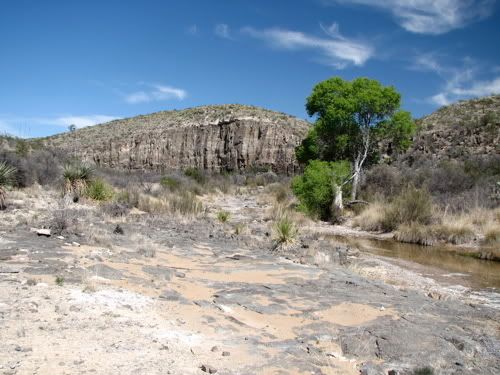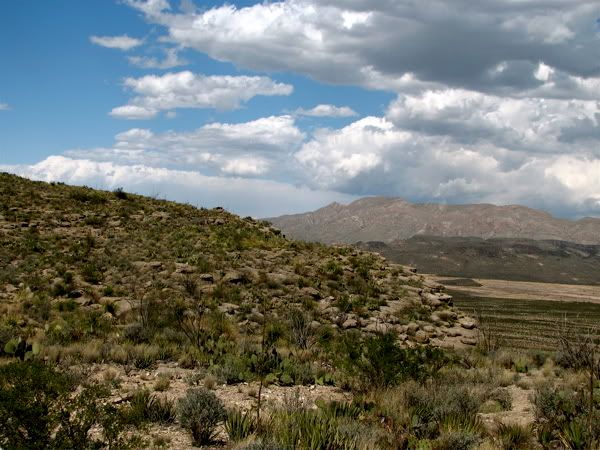Rides, ramblings and rants on a motorcycle.
3.19.2007,6:51 PM
Desert Solitude: The Awakening

There are things in Texas worse than a mere fifty miles of rock and sand. I’d rather be broke down and lost in the wilds of Big Bend, any day, than wake up some morning in a penthouse suite high above the megalomania of Dallas or Houston.
-Edward Abbey
Disorder and Early Sorrow, 1952
Decades ago I was treated to my first American desert experience outside of Tucson, Arizona, by a man who grew up there. Ironically, my first desert exposures were in the Middle East. There both human and non-human life learned to eek out a living over thousands of years. The nomads of the African and Middle Eastern deserts traveled where they could find water and food to sustain them. Here on this continent, a similar process evolved beginning with the southward migration of humans that would become ancestors of the North, Central and South American indigenous peoples.
Back then, and only until relatively recent times, there were no borders, no boundaries except those that were not man-made. Yet, like the natural recourse of human habitation, we contrived boundaries of our territories: us against them. This is the line; don’t cross over it. Those borders instigate human history in many ways.
Driving down into south central and southwest Texas, you pass through towns and counties. Signs announce their presence, but the land has no real borders. These boundaries are all man-made. The land gradually flows from one formation to the next, or abruptly with towering mesas or drop-offs. Other times the flat dry ground seems to stretch out forever, neverchanging.
Vegetation changes, too, depending on the terrain. If you are astute enough, you can spot the greener ribbons that border streams and rivers even when the water is hidden. Along seasonal creeks and washes the brief extension of water availability will provide enough sustenance for plants that have a greater thirst than the desert natives. In the deep desert, the bright lime green of cottonwood leaves betrays a nearby spring.

These lands are full of contrasts; geography, animals, vegetation, and even human life. The most famous area is the 800,000-acre Big Bend National Park. But there is so much more than just the park.
I’ve heard the region encompassing the state and national parks, the wildlife refuge, and the river as “The Big Empty”. Or “God’s Country”, “Paradise”, “Devil’s Playground”. I recall perusing topo maps before my trip down there, smirking at some of the names given to landmarks: Dealer’s Gap, Mule Ears, Dog Canyon, Elephant Mountain, and more. Some quite entertaining, some named after a long-dead person, others with religious names, many with assigned descriptive names, such as ‘The Window’.
But when you are there, you sometimes invent your own personal name for a landmark. I christened a peak in Black Gap as “Randy’s Monolith” because he was enthralled with its presence. I’m sure it probably has an accepted toponym decreed by someone long ago and propagated over time without dissent, eventually being recorded on a map and copied over and over again.
But if you are truly in the desert, and a part of it, you don’t remember or care about names. You can make up any name you want for anything there. Or see and know landmarks without a name.
Edward Abbey once wrote about the human propensity to ascribe everything with a name:
“Unless we can name things, they remain for us only half-real. A man’s name can become more important than his person. A plant, an animal, a thing without a name is no thing – nothing. No wonder we humans like to think that in the beginning was – the Word. What word? Any word at all, anything rather than the silence and terror of the nameless.”
Having shared that viewpoint all my life, I often make up names for things already named. Sometimes things remain nameless. Even people.
The Indians sometimes gave many names to living and non-living things, including each other. Not uncommonly, one Indian could have many names. Never were they names that Europeans use. No Indian chose to be Robert or Ester without a strong European influence, or even Anglo-American coercion. Even after death, many Indians were buried the Anglo way and assigned Anglo names that were inscribed on their headstones. I witnessed this in several cemeteries, most recently one in Fort Sill (Oklahoma) where Geronimo was buried.
With reluctance I have referenced that region in south Texas as ‘Big Bend Country’. But inside I call it the desert and canyons. Because there is so much more than the park.

They are all one big family: those of the Grand Canyon, the canyons, mountains, barrancas and deserts of Utah and Nevada, the jeweled Palo Duro canyon, the sand-blown dunes of the Red Desert in Israel and in Death Valley, California; the steep-walled narrow canyons and the wide sweeping and sloping barrancas that often nestle at the foot of or alongside jagged mountains.
They all represent one thing: time immortal and the struggle for life. For the necessities of living: water, shelter and food. Relatively few large mammals live in the desert because most cannot store sufficient water and withstand the heat. Small is an adaptation to living in a desert. Little shelter from the sun is available for large animals. Including humans.
Topography and rainfall dictate the species that live in the deserts and canyons. It is life in its most basic form, all struggling and competing for the same nutrients and shade to live. It’s no different in the southern Texas desert.
The name Big Bend arose from the large expansive turn of the Rocky Mountain-born river, Rio Grande, as it flows from the southwest and bends to the northeast, then south again. Indian legend relates that after the Great Spirit finished the creation of the world he took all the rocks, trees, plants and animals that remained and dumped them in the Big Bend. That legend’s origin is easy to see given the contrasts in geography and life forms. Even the course of the river.
But to me, it’s desert and canyon country. And a place I’ve called ‘home’ even before my first exposure to it. All the deserts and canyons. And again, like so many years ago, I’ve been led back by someone who knows and loves the deserts like I do. It was like an Awakening.
This is a tale of one of my visits back Home.

Labels: Adventures, Big Bend

